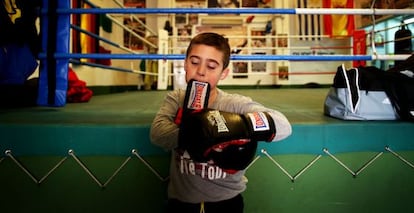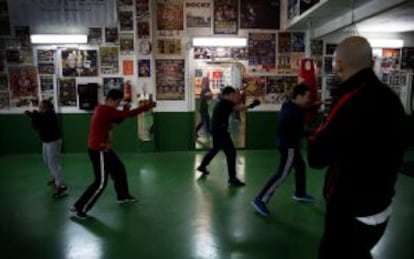Boxing clever?
Growing numbers of Spanish boys are taking up the sport, raising concerns among medics


This Christmas, Santa Claus brought 10-year-old Izan Pérez a magic set. But even at this young age, the boy already has it clear in his mind what he wants to be when he grows up: “I’m going to be a boxing world champion, and every now and then I’ll perform a bit of magic,” says Pérez, who trains at the San Crístobal boxing club, located in Valencia’s former port district.
The club, which looks like something out of Rocky, is run by former boxer Sento Martínez. Izan is one of his star pupils, and has already been dubbed the Valencia Colt. He’s one of the thousand or so under-15s in Spain who practice what the country’s boxing federation calls “educational, non-contact boxing.” Martínez, who has groomed three members of Spain’s Olympic team, explains that his pupils do not fight other boxers: “This is about coordination, self-discipline, and fair play. It’s simply another sport, like soccer or judo.”
Minors don’t know how to manage violence and it could generate more violence. They should not see nor practice boxing” Educational psychologist Juan Antonio Plazas
But whether youngsters like Izan are, for the moment, simply in training, is not the issue, argue those who disagree with encouraging boys to box at all. “This fashion for getting boys into contact sports is worrying,” says educational psychologist Juan Antonio Plazas. “They don’t know how to manage violence and it could generate more violence. Minors should not see nor practice boxing. Even if a boy is hitting a bag, it’s still an act of violence. This shouldn’t be banalized, being aggressive with one’s fists is unjustifiable.”
Although very few of the boys in Sento Martínez’s gym will go on to become professionals, José Ramón Huerta, spokesman for Spain’s medical council, highlights the dangers boxers face: “Between 2000 and 2010, 68 boxers died around the world, which is barbarous. Yes, people die in climbing accidents or driving racing cars, but the idea in those sports is not to inflict damage on your opponent. It should be banned.”
Plazas is right: boxing is growing in popularity in Spain, particularly among young boys.
Last December, the Spanish Boxing Federation held the first national Olympic boxing championships for school-age boys, which put the 56 contestants aged between eight and 14 to three tests in a minute: skipping, punch bag, and shadow boxing. “We’re aware of the opposition to boxing in Spain, so we’re very, very, careful,” says Pedro Retuerto, head of the Spanish Boxing Federation. Izan won in his age group, taking three medals and a trophy.
Minors in the ring
- In the United Kingdom, boys can fight from the age of 11; in the United States, from the age of eight, although the American Academy of Pediatrics advises against it. Spain's Sports Council only allows boys to fight in the ring from the age of 15.
- In Spain, junior fights, between boys aged 15 and 16, are shorter than adult competitions, and points are given for the number of direct hits on an opponent. Helmets and gloves with an inner tube are compulsory.
- In some regions, such as Valencia, boys are allowed to join the Spanish Boxing Federation from age 14.
- In Madrid, minors are not allowed to attend boxing matches.
Izan’s parents are proud of their youngster. “We found that soccer at school was much more violent; in the ring there is more respect between opponents,” says his mother, Tere Guillem, a 32-year-old hairdresser.
Izan’s father, an unemployed carpenter, has been boxing since he was a boy, and at one point ran a gym. “We’re talking about an Olympic sport here. I don’t know why people have this thing about boxing being violent … the problem in Spain is that there’s no tradition of boxing. In Las Vegas, a boxing champion is like Messi.”
In the United States, where thousands of minors box in pairs from the age of eight, the American Academy of Pediatrics advises parents against allowing under 18s to box, highlighting the risks of brain and facial damage. “There is less risk of injury than say in soccer, hockey, American football, or rugby, but the difference is that boxing is about hitting somebody in the face and the head,” its website reads.
The Spanish Association of Pediatricians has yet to take a view on boxing among minors. “It’s still a minority sport here,” says its spokesman Gerardo Rodríguez. “In general, children should avoid any of the martial arts, even if they aren’t delivering blows.”
In the United States, boxing has proved a way of channeling young men’s energy into something positive for decades. Jero García, a former Spanish boxing champion, hopes to emulate that approach through La Escuela, his gym in the working-class Madrid district of Carabanchel, where he trains around 30 local boys, as well as youngsters sent to him by social workers and educationists. “I’m looking for people, not boxers. Our war cry is education, study,” he says. “We used to get guys coming here to train to box in competitions, now we have doctors and lawyers.”

But sports psychologist Patricia Ramírez says what makes boxing different, and more dangerous, is that it is largely focused on striking the head of the opponent. “Even other contact sports or martial arts limit blows to the head. And even if boys do not actually hit each other, they know that real boxers do: if you play tennis you want to be Rafa Nadal, and all he represents, if you box, then your hero is the champion who knocks somebody else out. As a mother I wouldn’t take my son boxing.”
Izan’s mother insists that her son is not aggressive: “He’s just a normal boy who likes boxing. He’s always been a good student, and since he started boxing he is less restless and more focused, all his teachers agree.”
Izan explains that he enjoys boxing, and agrees that it helps him focus. “When I’m in the ring, I’m concentrating on what I’m doing.” To prove his point he runs through a few of his shadow boxing moves, hitting the air with a couple of precise, hard blows, and suddenly, his hands no longer seem to belong to a child.
Tu suscripción se está usando en otro dispositivo
¿Quieres añadir otro usuario a tu suscripción?
Si continúas leyendo en este dispositivo, no se podrá leer en el otro.
FlechaTu suscripción se está usando en otro dispositivo y solo puedes acceder a EL PAÍS desde un dispositivo a la vez.
Si quieres compartir tu cuenta, cambia tu suscripción a la modalidad Premium, así podrás añadir otro usuario. Cada uno accederá con su propia cuenta de email, lo que os permitirá personalizar vuestra experiencia en EL PAÍS.
¿Tienes una suscripción de empresa? Accede aquí para contratar más cuentas.
En el caso de no saber quién está usando tu cuenta, te recomendamos cambiar tu contraseña aquí.
Si decides continuar compartiendo tu cuenta, este mensaje se mostrará en tu dispositivo y en el de la otra persona que está usando tu cuenta de forma indefinida, afectando a tu experiencia de lectura. Puedes consultar aquí los términos y condiciones de la suscripción digital.
Últimas noticias
Reinhard Genzel, Nobel laureate in physics: ‘One-minute videos will never give you the truth’
Pinochet’s victims grapple with José Antonio Kast’s rise in Chile
From digital curfews to blocking apps: How technology experts protect their children online
Why the price of coffee has skyrocketed: from Brazilian plantations to specialty coffee houses
Most viewed
- Pablo Escobar’s hippos: A serious environmental problem, 40 years on
- Why we lost the habit of sleeping in two segments and how that changed our sense of time
- Trump’s obsession with putting his name on everything is unprecedented in the United States
- Charles Dubouloz, mountaineering star, retires at 36 with a farewell tour inspired by Walter Bonatti
- The Florida Keys tourist paradise is besieged by immigration agents: ‘We’ve never seen anything like this’








































